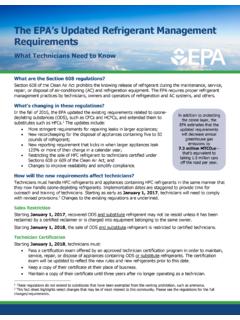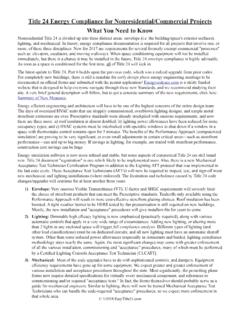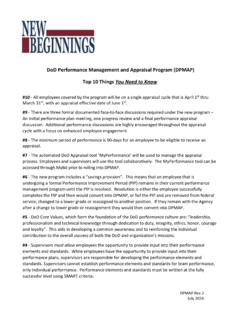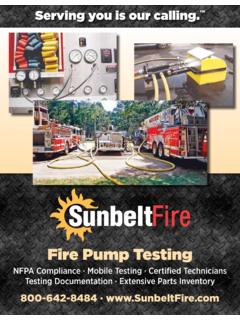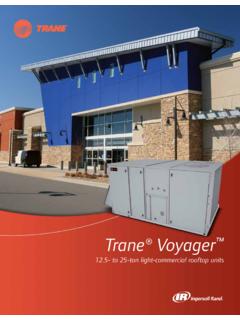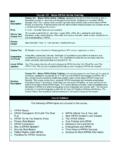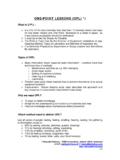Transcription of System Smoke Detectors
1 APPLICATIONS GUIDES ystemSmoke DetectorsAPPLICATIONS GUIDE: System Smoke DETECTORS2 ForewordThe use of early warning fire and Smoke detection systems results in significant reduction in fire deaths. The sooner a fire is detected, the better the out-come for saving lives. This document provides guidance for the proper operation of fire detection systems for those who apply, install, and maintain installation and maintenance of Smoke Detectors prevents unwanted nuisance alarms. Occupants can become desensitized when repeated nuisance alarms occur. In worst case scenarios, technicians could disconnect alarms from the System to avoid the unnecessary disruption. Either situ-ation negates a detector s potential life saving benefit, making the proper operation of an early warning fire and Smoke detection System indispensable. SystemSmoke DetectorsContentsForeword ..2 Introduction ..3 NFPA Codes and Standards ..3 Standards That Apply ..3 Building and Fire Codes ..3 Testing Laboratories.
2 3 Industry Publications ..3 Manufacturer s Publications ..3 Ionization Smoke Detector Operation ..4 How Smoke Detectors Work ..4 Photoelectric Smoke Detector Operation ..5 Photoelectric Light Scattering Smoke Detector ..5 Photoelectric Light Obscuration Smoke Detector ..5 Smoke Detector Design in Selecting Detectors ..5 Smoke Detector Limitations ..6 Typical System Layout ..6 Wiring Supervision ..6 Class B Circuits ..6 Class A Circuits ..6 Wireless Circuits ..7 General Zoning Guidelines ..7 Fire Safety Functions ..7 Smoke Detector Installation ..7 Wireless Systems ..9 Installation Dos and Don ts ..9 Proper Detector Applications, Placement, and Spacing* ..9 Where to Place Detectors ..9 Where Not To Place for Smoke Detectors ..11 Detector Spacing ..11 Detectors in Air Handling and Air Conditioning Systems ..13 Detectors in Above-Ceiling Plenum Areas Including Those Utilized as Part of the HVAC System ..13 Testing, Maintenance, and Service of Detectors ..13 Typical Inspection, Test, and Maintenance Practices.
3 13 Troubleshooting Techniques ..14 What to Do About Unwanted Alarms ..14 Reasons for Unwanted Alarms ..14 Maintain an Alarm Log ..14 Effects of Location or Environment ..14 Inspect Detector for Dirt, Review Maintenance ..15 Effects of Other Systems on Alarm System ..15 Miscellaneous Causes of Unwanted of Detector Owners and Installers ..15 Where to Get Help if the Source of Unwanted Alarms Cannot be Found ..16 Glossary of Terms ..17 Fire Alarm Log ..19 System SENSOR3 Building and Fire CodesInternational Code Council, Inc. (International Building Code/International Fire Code)BOCA, ICBO, and SBCCI formed an umbrella organization known as the International Code Council (ICC), to combine their codes into a single set of model building and fire codes. The ICC International Building Code and International Fire Code were first published in 2000 and were adopted by some Workman Mill RoadWhittier, CA 90601-2298 Testing LaboratoriesTesting laboratories test Smoke Detectors , control panels, and other compo-nents of fire alarm systems to verify conformance with NFPA requirements and their own standards.
4 Equipment that passes their tests is identified by a label and/or Laboratories, Inc. (UL)333 Pfingsten RoadNorthbrook, IL 60062455 E. Trimble RoadSan Jose, CA 951311285 Walt Whitman RoadMelville, NY 1174712 Laboratory Drive, Box 13995 Research Triangle Park, NC2600 Lake RoadCamas, WA 98607UL publishes an annual directory of fire protection equipment which bears the UL label. The following standards apply to Smoke Detectors . UL 217: Single and Multiple Station Smoke DetectorsUL 268: Smoke Detectors for Fire Protection Signaling SystemsUL 268A: Smoke Detectors for Duct ApplicationsUL 864: Standard for Control Units for Fire Protective Signaling SystemsFactory Mutual Research (FM)1151 Boston-Providence Turnpike, Box 9102 Norwood, MA 02062FM publishes an annual report listing fire protection equipment which bears its PublicationsNEMA Guide for Proper Use of Smoke Detectors in Duct ApplicationsNEMA Training Manual on Fire Alarm SystemsNEMA Guide for Proper Use of System Smoke DetectorsManufacturer s PublicationsThe manufacturers of the Smoke Detectors being used should be contacted for any published information pertaining to their basic types of Smoke Detectors are used today: ionization and photo-electric.
5 The sensing chambers of these Detectors use different principles of operation to sense the visible or invisible particles of combustion given off in developing purpose of this guide is to provide information concerning the proper application of Smoke Detectors used in conjunction with fire alarm sys-tems. The guide outlines basic principles that should be considered in the application of early warning fire and Smoke detection devices. It presents operating characteristics of Detectors and environmental factors, which may aid, delay, or prevent their document presents information for fire protection, mechanical, and electrical engineers; fire service personnel, fire alarm designers; and install-ers. A key element in the effectiveness of Smoke detection systems is the latest version of NFPA 72 for installation and testing of systems. Installation must comply with all code requirements and directions from Authorities Having Jurisdiction (AHJs). AHJ directives always take precedence over other codes and exercise final authority over installations and maintenance Codes and StandardsSection 1 Standards That ApplyNFPA publishes standards for the proper application, installation, and main-tenance of automatic Smoke Detectors .
6 The principal codes and standards, which should be reviewed before specifying or installing automatic Smoke Detectors are listed Fire Protection Association (NFPA)Batterymarch ParkQuincy, MA 02269-9101 NFPA publishes codes and standards concerning all phases of fire protec-tion. These apply to automatic Smoke 70: National Electrical CodeNFPA 72: National Fire Alarm Code and Signaling CodeNFPA 72 covers minimum performance, location, mounting, testing, and maintenance requirements of automatic fire Detectors . Many NFPA-application specific standards are available and should be considered in addition to NFPA 72, when 90A: Standard for the Installation of Air Conditioning and Ventilating SystemsNFPA 90B: Installation of Warm Air Heating and Air-differentialsNFPA 92B: Smoke Control Systems in Malls, Atria, and Large AreasNFPA 90A and 92B provide information for the use of Smoke Detectors in ducts of heating, ventilating, or air conditioning (HVAC) systems and Smoke control 101: Life Safety CodeNFPA 101 specifies the requirements for Smoke detection in both new and existing buildings depending on the type of GUIDE: System Smoke DETECTORS4 Ionization Smoke Detector OperationA typical ionization chamber consists of two electrically charged plates and a radioactive source (typically Americium 241) for ionizing the air between the plates.
7 (See Figure 1.) The radioactive source emits particles that col-lide with the air molecules and dislodge their electrons. As the molecules lose electrons, they become positively charged ions. As other molecules gain electrons, they become negatively charged ions. Equal numbers of positive and negative ions are created. The positively charged ions are attracted to the negatively charged electrical plate, while the negatively charged ions are attracted to the positively charged plate. (See Figure 2.) This creates a small ionization current that can be measured by elec-tronic circuitry connected to the plates ( normal condition in the detector).Particles of combustion are much larger than the ionized air molecules. As particles of combustion enter an ionization chamber, ionized air mol-ecules collide and combine with them. (See Figure 3.) Some particles become positively charged and some become negatively charged. As these relatively large particles continue to combine with many other ions, they become recombination centers, and the total number of ionized par-ticles in the chamber is reduced.
8 Section 2 How Smoke Detectors WorkThis reduction in the ionized particles results in a decrease in the cham-ber current that is sensed by electronic circuitry monitoring the chamber. When the current is reduced by a predetermined amount, a threshold is crossed and an alarm condition is in humidity and atmospheric pressure affect the chamber current and create an effect similar to the effect of particles of combustion entering the sensing chamber. To compensate for the possible effects of humidity and pressure changes, the dual ionization chamber was developed and has become commonplace in the Smoke detector dual-chamber detector utilizes two ionization chambers; one is a sens-ing chamber, which is open to the outside air. (See Figure 4). The sensing chamber is affected by particulate matter, humidity, and atmospheric pres-sure. The other is a reference chamber, which is partially closed to outside air and is affected only by humidity and atmospheric pressure, because its tiny openings block the entry of larger particulate matter including particles of combustion.
9 Electronic circuitry monitors both chambers and compares their outputs. If the humidity or the atmospheric pressure changes, the out-puts of both chambers are affected equally and cancel each other. When combustion particles enter the sensing chamber, its current decreases while the current of the reference chamber remains unchanged. The result-ing current imbalance is detected by the electronic circuitry. (See Figure 5.) There are a number of conditions that can affect dual-chamber ioniza-tion sensors such as dust, excessive humidity (condensation), significant air currents, and tiny insects. All of these can be misread as particles of combustion by the electronic circuitry monitoring the sensors. Figure 1: Particle Radiation Pattern Figure 2: Ion DistributionFigure 3: Ion and Particles of Combustion DistributionSensing ChamberSourceReference Chamber(Current Stable)Figure 4: Dual ChamberSensing Chamber(Current Decreasing)ReferenceChamber(Current Stable)Figure 5: Dual Chamber with Particles of CombustionSYSTEM SENSOR5 Photoelectric Smoke Detector OperationSmoke produced by a fire affects the intensity of a light beam passing through air.
10 The Smoke can block or obscure the beam. It can also cause the light to scatter due to reflection off the Smoke particles. Photoelectric Smoke Detectors are designed to sense Smoke by utilizing these effects of Smoke on Light Scattering Smoke DetectorMost photoelectric Smoke Detectors are of the spot type and operate on the light scattering principle. A light-emitting diode (LED) is beamed into an area not normally seen by a photosensitive element, generally a pho-todiode. (See Figure 6.) When Smoke particles enter the light path, light strikes the particles (Figure 7) and is reflected onto the photosensitive device causing the detector to Light Obscuration Smoke DetectorAnother type of photoelectric detector, the light obscuration detector, employs a light source and a photosensitive receiving device, such as a photodiode (see Figure 8). When Smoke particles partially block the light beam (Figure 9), the reduction in light reaching the photosensitive device alters its output.

